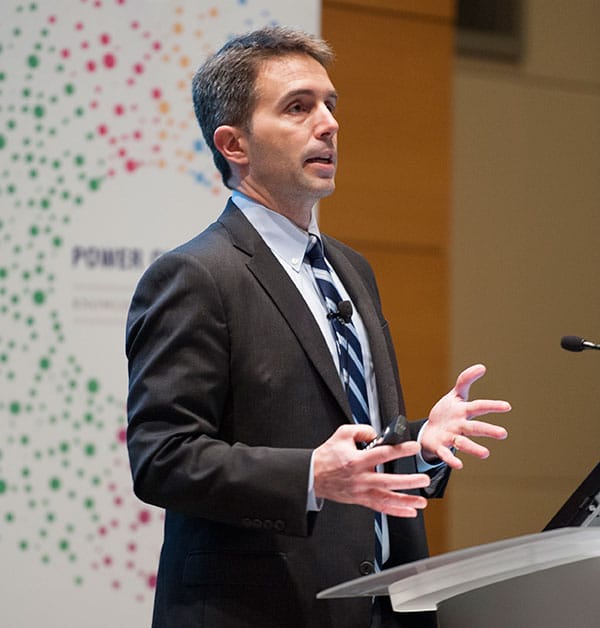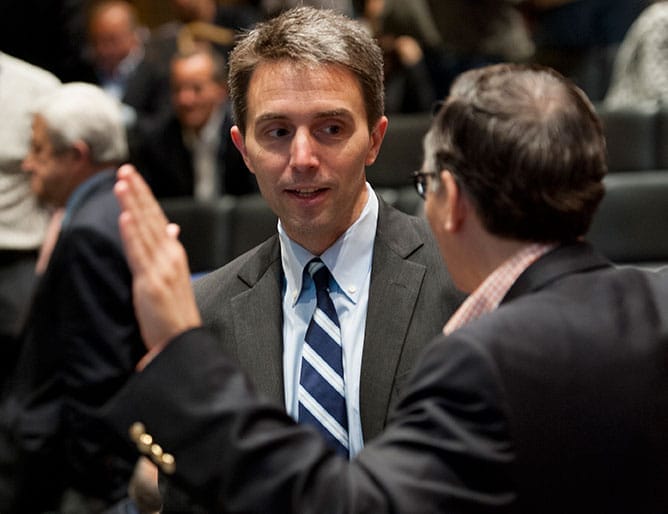Mark Duggan is perhaps best known for discussing public policy issues surrounding health care. He was, after all, part of the Obama administration’s Council of Economic Advisers and helped to tackle the issue of health care reform during the president’s first term. He recently chose another public policy issue to present about for Wharton alumni—energy.

Prof. Mark Duggan presents during the 2014 Wharton MBA Reunion. Photo credit: Phil Flynn.
For climate change skeptics, Duggan’s talk may have disappointed. The faculty director of the Penn Wharton Public Policy Initiative holds plain that human activity and greenhouse gases are responsible for a big part of the climate change that is already in progress.
Based on that foundation, he then posited three facts about climate change:
1. Energy production is the main source of harmful emissions. It makes up roughly 60 percent of CO2 emissions; whereas agriculture represents 14 percent, land use 18 percent.
2. Energy consumption is growing rapidly around the world. Nations with higher GDPs tend to have higher emission rates per person, and as nations’ GDPs grow, so do their emissions. Case in point: massive developing economies like China and India are set to take off into the steepest part of an S-shaped curve for emissions growth, if they mirror patterns of development seen in the U.S., Germany, U.K. and elsewhere.
Energy consumption, Duggan cited, is expected to double worldwide between now and 2050.
Can this be stopped?
“Developing countries feel that it is their turn,” Duggan said, meaning their time to grow their economies and join the ranks of developed nations.
If it can’t be stopped, can the types of energy being consumed be greener?
3. Renewable energy sources are expected to grow.
“But not much more than rounding error” in the grand scheme of energy sources, warned Duggan.
Oil, coal and gas are expected to continue to be the big three sources of energy for the world for at least the next 30 years, he said.
Connect with us: Listen to an audio recording of the presentation on the Penn Wharton PPI iTunesU channel, or download a PDF of Duggan’s presentation, including detailed data on climate change and energy policy.
Given these three rules, the world will soon be well beyond what’s considered the far range of safe for CO2 atmospheric concentration, 450 parts per million. We may already be well beyond what’s safe, he added, given two recently published studies about melting glaciers in western Antarctica. Their findings suggest that projected sea level increases could be too low.
So back to public policy. What can countries do?
One solution for the U.S. that Duggan pointed to is a cap-and-trade system similar to the one that worked in the U.S. for sulfur dioxide, the pollutant commonly associated with acid rain. Another, a policymaker favorite in Europe, is the gas tax.
If U.S. policymakers commit to new anti-CO2 policies—and that is a big if—they ought to be wary of unintended consequences. For illustration, Duggan pointed to Corporate Average Fuel Economy (CAFE) rules. Though they are credited with improving the fuel efficiency of cars on U.S. roads, automakers have certainly found ways to work around the rules—like calling SUVs light trucks (thereby getting different standards than cars) or by installing a fuel efficiency device in Corvettes and then telling owners how to disable it.
Duggan served as the keynote speaker at the Wharton MBA Reunion on May 16, 2014. Follow the Wharton Blog Network in the coming days for more Reunion highlights, and share yours with us by email at magazine@wharton.upenn.edu or in the comments section below.


























